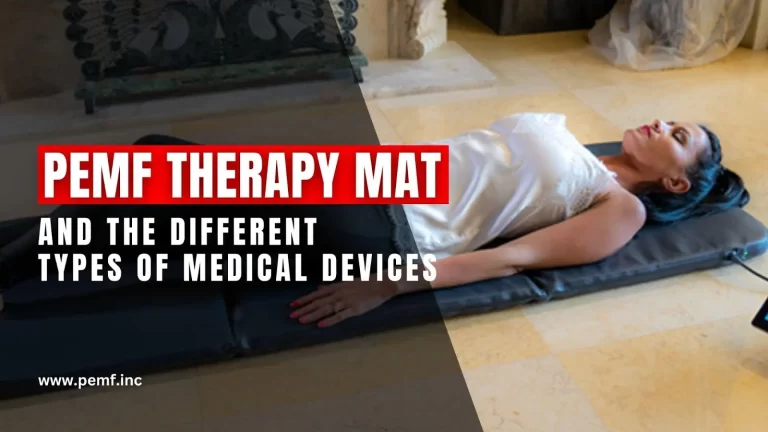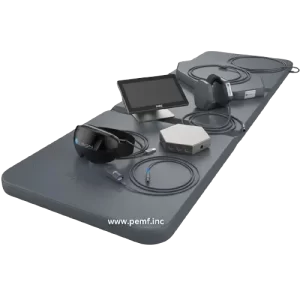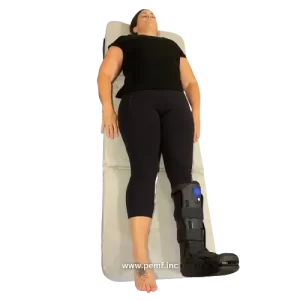PEMF Therapy Mat and the Different Types of Medical Devices

It has almost become natural for us to deal with various ailments or illnesses at least once in our lives. That is why we always look for new ways to enhance our well-being and address different health concerns.
One innovative solution that gained attention is a PEMF therapy mat. These mats harness the power of the Earth’s electromagnetic waves to provide a non-invasive, nondrug, and painless option aimed at supporting overall health and wellness
In this blog, we’ll discuss the importance of PEMF therapy and examine other medical devices used to enhance health.
What Is PEMF Therapy Mat?
PEMF therapy mats are designed to send out pulses of electromagnetic waves at different frequencies to stimulate and encourage the body’s natural recovery process. The technology follows the principle that the Earth’s magnetic field positively influences our health.
By mimicking these natural frequencies, PEMF therapy mats aim to restore the electrical balance within the body’s cells, which can be disrupted by illness, stress, and external environmental factors.

A pulsed electromagnetic field device can lead to various health advantages, including enhanced muscle function, improved circulation, and reduced inflammation and pain. Furthermore, studies have shown that a PEMF machine can aid in bone healing, which is particularly beneficial for individuals who have osteoporosis or those recovering from fractures.
Different Types of Medical Devices
Aside from pulsed electromagnetic field therapy devices, the medical industry also has a wide range of devices designed to support our health and well-being. Each of these machines caters to different needs so that you can choose the most suitable method for your health improvement journey.
Here’s an overview of the different types:
Diagnostic Devices
Diagnostic devices offer a glimpse of the body’s inner workings, making them essential in the medical world. They range from simple tools like stethoscopes and blood pressure monitors to more complex machinery like MRI scanners and CT machines.
ith these devices, healthcare providers will have a clearer view of what is happening in your body. Then, they can detect diseases and conditions accurately, even in their early stages. Ultimately, this paves the way for timely and effective intervention before it’s too late.
For instance, glucose monitors provide real-time blood sugar levels for diabetics, while electrocardiogram (ECG) machines track heart activity, which is crucial for diagnosing cardiac conditions.

Therapeutic Devices
Therapeutic devices are designed to treat or manage medical conditions by aiding recovery or alleviating symptoms. This machine type includes a wide range of devices, including infusion pumps for delivering medications, ventilators for respiratory support, and dialysis machines for renal failure patients.
In addition to pulsed electromagnetic field therapy machines, surgical instruments, laser therapy devices, and physical therapy equipment fall under this category. Nevertheless, they all play a unique role in the patient’s recovery or treatment journey.
The advent of wearable therapeutic devices, such as insulin pumps and TENS units for pain management, marks a significant stride towards more personalised and accessible care.
Assistive Devices
The purpose of assistive medical devices is to help improve the quality of life for individuals with disabilities, injuries, or chronic conditions. By using these devices, patients can function better despite their health issues as they can facilitate independence and help patients participate in daily activities.
Prosthetics, orthotics, hearing aids, and mobility aids such as wheelchairs and walkers are some examples of medical devices in this category.
Additionally, recent innovations have introduced advanced assistive technologies, including robotic exoskeletons for rehabilitation and smart glasses for the visually impaired. This development demonstrates the potential of technology to break barriers and empower individuals.
Monitoring Devices
Monitoring devices measure and record physiological parameters, offering critical insights into a patient’s health status, often in real-time. These devices are beneficial in critical care settings and for managing chronic conditions.
With the advancement of technology, we already have wearable monitors that can track heart rate, oxygen levels, and sleep patterns, making it easier for us to seamlessly integrate these machines into our lives.
In hospital settings, multi-parameter patient monitors provide comprehensive data, including ECG, blood pressure, and respiratory rate. These monitors are essential for making informed clinical decisions.
Implantable Devices
Implantable devices are placed inside the body temporarily or permanently. They replace missing biological structures, support damaged organs, or deliver therapy directly where it’s needed.
Pacemakers, defibrillators, cochlear implants, and intraocular lenses are examples of these devices, which have helped improve and extend countless lives.
In addition, the development of bioresorbable implants that naturally dissolve in the body after fulfilling their purpose reduces the need for additional surgeries—therefore minimising long-term complications.

Laboratory Devices
Laboratory devices are crucial for analysing blood, urine, genetic material, and other specimens to diagnose conditions, monitor disease progression, and guide treatment decisions.
Centrifuges, spectrophotometers, microscopes, and PCR machines are some examples of these devices. They allow for a range of tests, from simple blood counts to complex genetic sequencing, which support the entire healthcare ecosystem in disease diagnosis and management.
Digital Health Devices
Now that technology has become more accessible, experts have developed countless digital devices that can help support our health. These machines include various technology-based tools that support health and wellness.
From mobile health apps and telehealth platforms to advanced software for medical imaging analysis, these devices leverage digital innovation to improve healthcare delivery.
Wearables and health apps encourage proactive health management by allowing individuals to monitor their health metrics. Meanwhile, telehealth devices facilitate remote consultations for easier access to healthcare services.
Start Your Wellness Journey with Our PEMF Therapy Machines
The development of medical devices like PEMF therapy mats and other health-improving technologies represents a significant advancement in personal health care. These devices offer new ways to manage and treat various health conditions and empower individuals to play an active role in managing their health.
PEMF.inc offers a wide range of PEMF therapy machines, including PEMF therapy mats, pads, and spot treatment applicators. If you want to learn more about our products, feel free to check our Product Page or contact us at 0414644120 for Australian customers or +61-414644120 for international clients.

